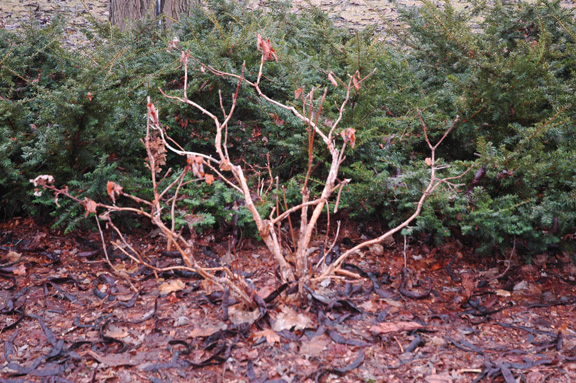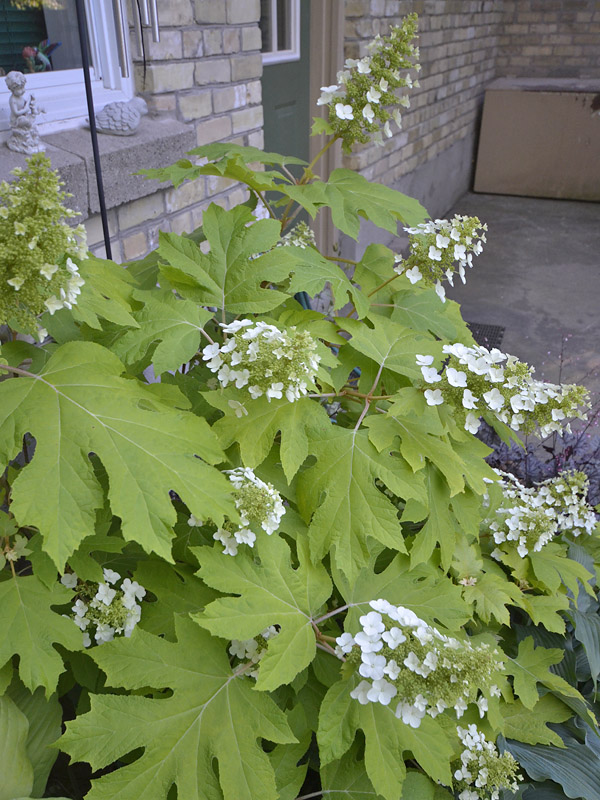
Woody > Hydrangea > Hydrangea quercifolia > Hydrangea quercifolia
Hydrangea quercifolia
Oak Leaf Hydrangea
Origin: Southern United States, including Mississippi, Alabama, Georgia and Florida.
Mike's
Opinion


"
A top notch plant that has now received the standing it deserves on the horticultural front. This is one of the few plants that has full year interest yet retains a degree of class and presence in the garden. A must have for the refined landscape.
Michael Pascoe, NDP., ODH., CLT., MSc. (Plant Conservation)
"
| Family |
| Hydrangeaceae (Saxifragaceae) |
| Genus |
| Hydrangea |
| Species |
| quercifolia |
| Category |
| Woody |
| Type |
| Shrub (deciduous) |
| Pronunciation |
| USDA Hardiness Zone |
| 5 |
| Canadian Hardiness Zone |
| 4 - 6a |
| RHS Hardiness Zone |
| H7 |
| Temperature (°C) |
| -35 - (-29) |
| Temperature (°F) |
| -30 - (-20) |
| Height |
| 1 - 1.5 m |
| Spread |
| 1.5 - 2.5 m |
Photographs
Description and Growing Information
Flowering Period
| General Description |
| A broad spreading shrub, with attractive panicles, autumn leaf colour and winter bark. |
| Landscape |
| Used as a mass or single specimen in full sun to partial shade. Since it is a large, broad spreading plant it should be given room to grow. |
| Cultivation |
| Easy to grow but in our climate needs to be sited in partial shade and out of harmful winter winds. Heavy mulch is recommended and supplemental watering is necessary in our often dry summers. |
| Shape |
| Broad spreading shrub. |
| Growth |
| Medium |
| ID Characteristic |
| Very large, coarse textured leaves similar to an oak leaf. Exfoliating bark. |
| Pests |
| Few that are serious although I have experienced wilt or vascular collapse on some stems of some plants. They seem to overcome this if they are in good vigour. |
| Habitat |
| Woods, as an understory plant. |
| Bark/Stem Description |
| Pale beige to dark brown, exfoliating in thin paper-like strips. |
| Flower/Leaf Bud Description |
| The terminal buds can be quite large, imbricate with 4-6 scales. |
| Leaf Description |
| The leaves are simple and opposite, 3-7 lobed, resembling a red oak leaf. Length is 20 cm while width is about 8 cm and held onto a petiole that can be 8 cm in length. Leaves are generally truncate at the base with broad lobes and serrate margins. |
| Flower Description |
| Panicles to 25-30 cm, that are held erect above the foliage in July-August; flowers are fragrant. |
| Fruit Description |
| Old flowers often persist on the plant even into the following growing season. Fruit is a beige coloured capsule. |
| Colour Description |
| Dull, light green leaves in summer, but turning intense red in the autumn. Mature branches can be a cinnamon brown. |
| Texture Description |
| A coarse textured plant. |
| Notable Specimens |
| The Gardens of Fanshawe College, London, Ontario, Canada. The A.M. Cuddy Garden, Strathroy, Ontario, Canada. Royal Botanical Gardens, Burlington, Ontario, Canada. |
| Propagation |
| Germination of fresh seed. Summer cuttings from June to September. According to Michael Dirr the plant is easy to root if his guidelines are followed. |
| Ethnobotanical Uses (Disclaimer) |
| May cause mild upset stomach if ingested. |

